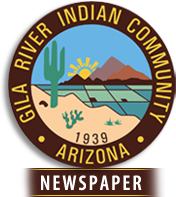A’AGA: Something to be told or talked about
Kui I’ivakitak (Mesquite Leaves) is a great time to be outside—just sitting in the sun, enjoying a walk, or riding in the ka:lit (car) with the windows rolled down so you can serenade the neighborhood with your playlist. Bill Bowerman, Olympic track coach and co-founder of Nike said there was no such thing as bad weather, just soft people. Maybe you’ve been out on the jeved (land), seen pottery shards and wondered how hahajun (cousins) dealt with their climate. Imagine our ancestors on trade routes to the Gulf or even early explorers in Arizona wearing armor while scouting “Tierra Nueva.” No Google Maps. No refrigerators. No Slurpies. Let us look at history of a few centuries back and read what the non-soft people did back then. Are we s-moik (soft) today?
In 1540, Commander and Captain-General Francisco Vasquez de Coronado left Compostela on February 23, leading an entrada of about 1300 looking for the “Seven Golden Cities of Cibola.” They marched north, but like Columbus they were a bit lost—they thought California was an island. Two ships sailed up the Colorado River “coast” to meet up and resupply Coronado. Surprise, they never rendezvoused with the ships! However, Coronado’s men returned with a tall Native. The tallest Spaniard could only reach the chest of the Native. The Native said taller men lived to the west. (Imagine that “conversation.”)
Detour to the future. A road crew was making improvements around Sycamore Creek near Prescott. On February 17, 1913, they unearthed a graveyard which revealed very big bones. Measurements led to an estimation that this individual could have been at least 8 feet tall. The crew chief verified the discovery, but did not realize the importance or sacredness of the site. The road crew finished and left. Nothing has been done since.
In July of 1540, the Coronado expedition reached the pueblo of Háwikuh, a Zuni pueblo in eastern Arizona. Coronado sent out men to explore. Don Pedro de Tovar reached the Hopi villages and Garcia López de Cárdenas reached the Grand Canyon. The Natives did not like the Spaniards and once they realized what Coronado was after, they told him the “Seven Golden Cities of Cibola,” were in the east. Coronado spent the winter along the Rio Grande, wore out his welcome with the Zuni, then marched eastward. When Coronado reached Kansas and still no treasure, he gave up the search for the “Seven Golden Cities of Cibola.”
Detour, back to the present. Archaeologist Deni Seymour was looking for Spanish explorer relics along the Santa Cruz River near Nogales. Her metal detector hummed; she began digging and found a 3.5-foot long, cast bronze cannon tangled within mesquite roots. It’s the oldest gun found within the continental United States. Dr. Seymour had been certain a settlement called San Geronimo III, aka Suya, had been here. Dr. Seymour also found 11 more Spanish sites from Nogales up to the Gila River. This may have been a trail of over 150 miles overlooked until now.
When the Spaniards entered O’odham lands, they probably met the Sobaipuri, akimel o’odham who farmed and lived along the rivers in southeastern Arizona. Being farmers they used canals to divert river water to fields, raising more food than needed. O’odham life changed from dependence upon “wild” plants and animals. Starvation could be avoided by the hard work of irrigation/raising food. But the Santa Cruz River wasn’t always full of water, it rose and vanished as it made its way along the Gila drainage. Like most akimel o’odham, Sobaipuri villages moved roughly every 20 or 30 years to be near surface water.
The Sobaipuri knew the trails and tribes along the rivers. An O’odham interpretation of their name means, “to be like the enemy,” S-o:bma, because they were fierce warriors. They decided to help the lost Spaniards, which could have been seen as aiding the enemy, and tribal alliances fell apart.
On the San Pedro River in 1698, a Sobaipuri O’odham village of 80 was attacked by a combined force of ancestral Apache, Jano, Jocome, Manso, Suma, and Jumano. On October 3, 1698, Pa:l (Padre) Kino’s guard, Capitan Diego Carrasco, was told of this battle from a Koahadk headman who had taken Tohono O’odham men to help the Sobaipuri. The O’odham prevailed. (Distinctive arrow points and the number of weapons found helped determine participants.) The the back-and-forth fighting became more frequent, and interfered with crop planting. The Sobaipuri abandoned the San Pedro River settlements, most went to San Xavier (Wa:k), some to Gila River. Many Wa:k O’odham residents are direct descendants of the Sobaipuri.
In 2007, Edmund Garcia was interviewed for the Sobaipuri O’odham Heritage Project and wore a t-shirt emblazoned, “Tucson, established 1692.” But Mr. Garcia pointed out, “We were here long before this. Tucson was not founded in 1692.” Mr. Garcia might also correct Google/Wikipedia/Safari because those sources say a Dublin born Irish immigrant to Spain named Hugo O’Conor founded Tucson. The name Tucson comes from a Spanish mispronunciation for a Sobaipuri O’odham village, San Cosme del Tucsón or San Cosme del S-cuk Shon or just S-cuk Shon.
Enjoy this beautiful Kui I’ivakitak. Try not to be so s-moik. Keep your eyes open, use the good eye to watch for snakes.
Information gleaned from.
#PrescottAZHistory: Road Crew Finds Giant Skeleton on Sycamore Creek; Archeologists find 500-year-old cannon in Arizona, oldest gun in US, Lane Sainty, USA TODAY, Jan. 2025;
O’odham Place Names, Meanings, Origins, Histories, Arizona and Sonora. Harry J. Winters, Jr. 2nd ed., 2020; Unveiling Tucson’s Birthplace: The Sobaipuri O’odham Village of San Cosme del Tucsón, by Deni Seymour. Journal of Arizona History 63(2). Summer 2022; Land of the Buzzard Clan and Their Mobile Neighbors: Exploring the Protohistoric in the Southern Southwest, by Deni Seymour. Journal of Arizona Archaeology, vol. 7, no 2; Video of Unveiling Tucson’s Birthplace: the Sobaipuri O’odham Villages. bing.com videos; Wa:k is how Tohono O’odham say and spell ‘standing water.’
